Dultmeier Sales stocks valves of all different makes, models, and applications. Here you will find all you need to know about the different types of valves we stock and the various applications they are used for. More importantly, we will help you determine what you need to know prior to making a valve purchase. Let's dig in...
Valve Definition & Common Trade Names
What is a valve? What are some common trade names, associated with, the valves that Dultmeier Sales stocks and distributes? In a nutshell, a valve is a product which is used to constrict, cut off, redirect, or regulate the flow of a liquid or gas. While we do sell pneumatic valves we will be primarily focusing liquid, or solution, valves for this educational segment. Some common trade names associated with the valves we stock are as follows: butterfly, ball, gate, globe, angle, needle, solenoid, check, regulating, diverter, foot, relief, unloader, backflow prevention, and float valves.
As with any product, it's crucial to identify the type of valve, the manufacturer, inlet/outlet size, operating and maximum pressures, solution temperature, and the solution passing through the valve. It's critical to know what solution is passing through the valve to ensure proper chemical compatibility. Knowing the solution's PH level can also be another important factor when determining suitable components and materials.
How to Size a Valve
We size valves similar to how we size pipe. Always measure the inside diameter of the inlet/outlet port. This will identify the size of the valve in question. A common mistake is that people measure the outside diameter of the inlet/outlet ports of a valve. There is one exception to this rule - if working with tubing - measure the outside diameter of the tubing. For hose and pipe, only pay attention to the inside diameter measurement.
If flow rate is important, the coefficient of volume (Cv) of various valves can be compared. Now, I understand that sounds rather technical. However, in layman's terms all that means is the higher the Cv for a valve, the more flow rate will pass thru it with the same pressure loss. In the majority of applications, this will be a non-factor but it is still important terminology to be aware of in the vast world of valves.
Manufacturer Identification & Valve Type Explained
Most manufacturers will have a metal tag on their valve bodies to identify their brand. That manufacturer tag will identify the brand of the valve, the model, and serial number. This is an important first step in identifying what product you currently have. That being said, let's begin with a look at butterfly valves.
Butterfly Valves
Here at Dultmeier Sales, we stock a variety of butterfly valves. In the butterfly valve world, it's important to first determine which style of butterfly valve you possess. The two most common styles are Wafer or Lug bodies. A wafer-style butterfly valve has "thru" bolt holes that run along through the outside rim of both pipe flanges. In contrast, a lug-style butterfly valve has threaded bolt holes on both sides of the valve body to allow for "end of line" applications. Lug-style butterfly valves are, generally, less common than wafer-style butterfly valves. Below, you will see a wafer-style valve on the left and a lug style valve on the right:
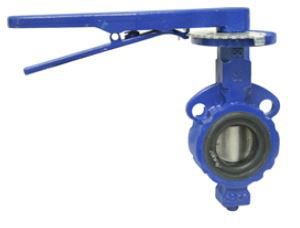

Butterfly Valve Actuators
Next, we get into the topic of valve actuation. We primarily stock butterfly valves that are manually (seen above with handle) or pneumatically actuated with either double acting or spring return actuators. A double acting butterfly valve actuator requires air pressure to open the valve and then air pressure to close the valve.
A spring return butterfly actuator is used in fail-safe applications. If there is a loss of air pressure the valve will automatically close (or open) - due to the spring tension of the actuator. Spring return actuators are used in many production plants that require system flow to cease once power is cut or lost - as mentioned above, this is a fail-safe application example.
Electric Actuators are also used in many industries. While we don't stock electric actuators for butterfly valves - we have access to them. Actuators can also be provided with "positioners", limit switches and other controls.
We stock Butterfly Valves and Air Actuators from Keystone and Pratt.
Ball Valves
A ball valve is probably the most common type of valve that exists - across all industries. It gets its name due to the fact that it actually has an internal ball that sits in a "seat". When the handle or knob is turned 90 degrees from the inlet/outlet ports, the valve is closed and one can see the convex shape of the internal ball. When the handle is turned parallel with the inlet/outlet ports, the valve is open and one can view through it - unhindered.
On the left, below, is an example of an air actuated, stainless steel, female pipe thread, ball valve. While on the right, you will see a Banjo, polypropylene, manual, flanged, ball valve.
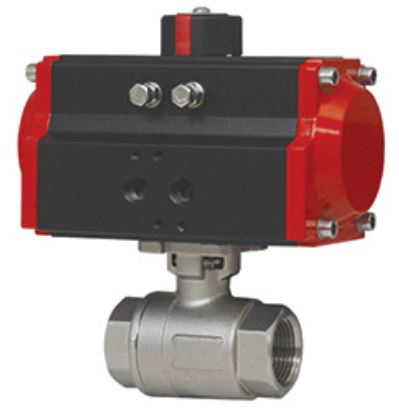
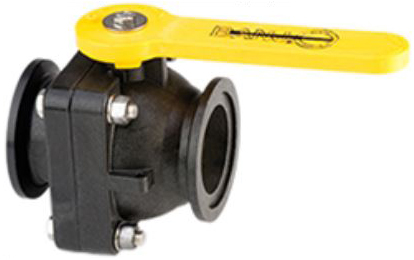
Standard Port vs. Full Port
By design, ball valves that are listed as Standard Port actually have less fluid path than the inlet/outlet ports size limitations - this is somewhat misleading to those that are unfamiliar with the concept of Standard vs. Full Port valves.
For example, if you have a 2 inch Standard Port valve your flow characteristics will be closer to that of a 1.5-inch fluid path. The technical reasoning behind this is the fact that a smaller opening creates more friction loss (i.e. pressure drop) thus resulting in a decreased flow rate. Standard port ball valves are cheaper than full port valves but restrict the system flow rates; somewhat. So, if flow rates don't matter or affect your system then you can save money up front by selecting standard port valve(s) for your plumbing system.
Full port valves allow the plumbing system to realize the full flow characteristics of the valving. If all valves in a system are two inch full port, valves then we can reasonably assume increased flow rates in comparison to a system that contains all standard port valving. A full port valve has a slight design change that allows for this increase in flow characteristics. While the valves may look the same externally, there are internal design changes that are not visible to the naked eye.
High Pressure vs. Low Pressure
This is another crucial step in determining the correct valve for a specific application. If necessary, place a pressure gauge at various points in the plumbing system to determine the system operating pressure. Never guess the operating pressure of a system. If a low pressure valve is installed into a high pressure system, serious or fatal injury could occur. As a general rule of thumb, anything below 150 psi is considered Low Pressure - that being said, there are valves rate for pressure less than 150 psi.
This gets back to one of our core fundamentals when selecting a proper valve - determine operating pressure and maximum pressure for the intended plumbing system.
Ball valves are a perfect example of how the same style valve can be used in multiple applications - both high pressure and low pressure. We have some ball valve product lines that have use applications which are limited to certain industries - due to their operating/working pressure limitations. However, we have many ball valve lines that carry over into multiple industry applications.
While we do carry many products that can be cross-utilized in various industries we always want the customer to confirm an operating pressure. This ensures safety in application and use. Furthermore, it minimizes the possibility of injury and lessens the chance of damage to the valve and other plumbing system components
Air Actuated & Electric Motor Driven
We carry ball valves that can be remotely operated via automation, as well. The most common types are pneumatic (air-operated) and electric motor-operated ball valves. Air operated are most widely used in chemical facilities, fertilizer plants, or industrial plants. Electric ball valves are most commonly used in agricultural applications for spraying applications. The trade name electric ball valve or pneumatic ball valve simply refers to how the valve is actuated.
When you drive down the road and see a large self-propelled sprayer, spraying in a field, you can be certain the booms are being remotely controlled. The boom valves are remotely controlled from the sprayer cab, with the help of electric ball valves. The sprayer operator sends a signal from his, in-cab, boom controller to turn certain sections of the sprayer boom on/off - based upon the field's specific application requirements.
We also see electric ball valves in the turf industry. Golf courses or residential sprayers will commonly use this type of ball valve on their sprayer setups. It is more prevalent in the turf industry due to the fact that the booms are much smaller than the agricultural industry.
Lastly, we do a fair amount of business in the liquid deicing industry. If you have ever seen a department of roads/transportation vehicle that is applying liquid before a winter storm - you have witnessed this industry in action. These vehicles are applying a solution called liquid salt brine (sodium chloride, magnesium or calcium chloride solution). Electric driven ball valves are common in this industry because pneumatic valve airlines would freeze in the frigid winter temperatures.
For those interested, here is a link that further explains the process of creating the salt brine solution. Below is a picture of a pneumatic-operated ball valve, on the left. On the right you will see an electric-operated ball valve.

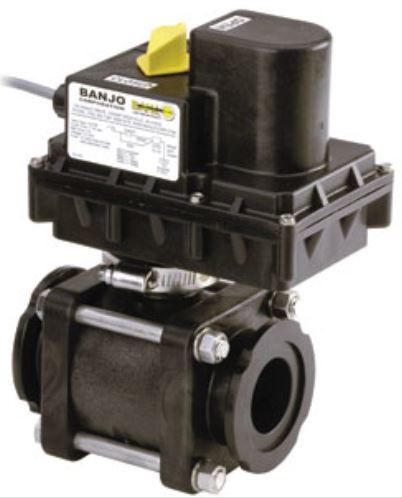
Gate Valves
A flanged gate valve is used in larger flow applications. In the Dultmeier world, we most commonly see this style of valve used on large bulk fertilizer, fuel tank storage applications, and float storage tanks in the vehicle and fleet washing industry. Gate Valves are generally designed with a circular handle that is turned clockwise to close the valve and counter-clockwise to open the valve.
Just as any other valve, we need to confirm the solution that will be passing through the valve to ensure chemical compatibility and then confirm the working or operating pressures that are required by the plumbing system. Most commonly, we are supplying flanged gate valves for lower pressure ranges. Below is a picture of a common flanged gate valve used in the bulk fertilizer industry.
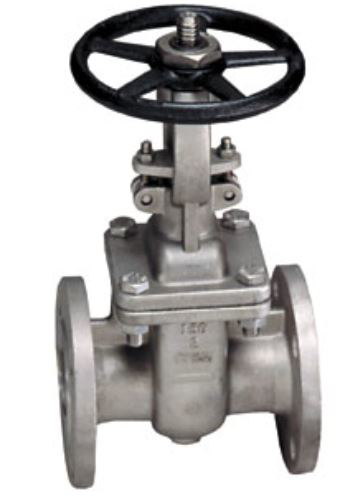
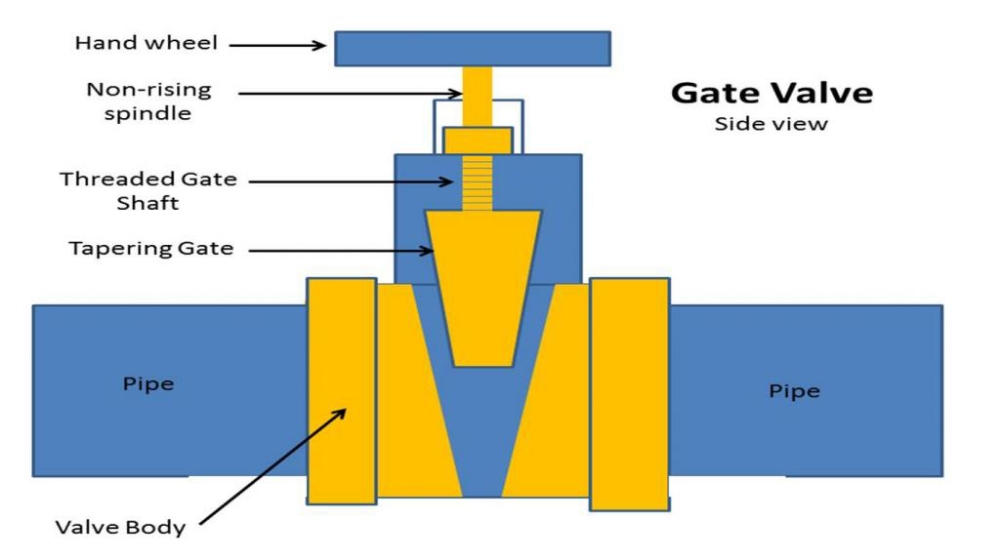
Globe & Angle Valves
A globe valve is very similar, from an external view, to that of a gate valve. However, when we look at the valves internally, they are quite different. As can be seen from the previous section, the gate valve operates almost like a wedge or slate that constricts or completely closes off flow. A globe valve has a different seat structure and more of a plunger that constricts or completely closes off flow. See below:

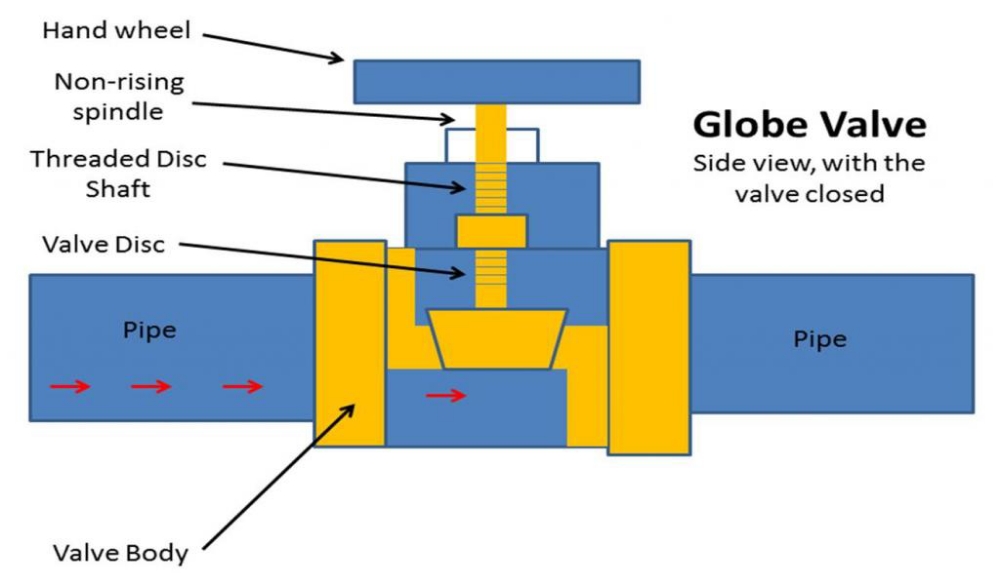
Below is a photo of a couple different sized globe valves on an Anhydrous Ammonia application. These valves are for a receiving bulkhead system where a plant facility will offload large bulk transports into their bulk storage tanks. The larger valve is on the liquid line transfer and the smaller valve is on the vapor transfer line.
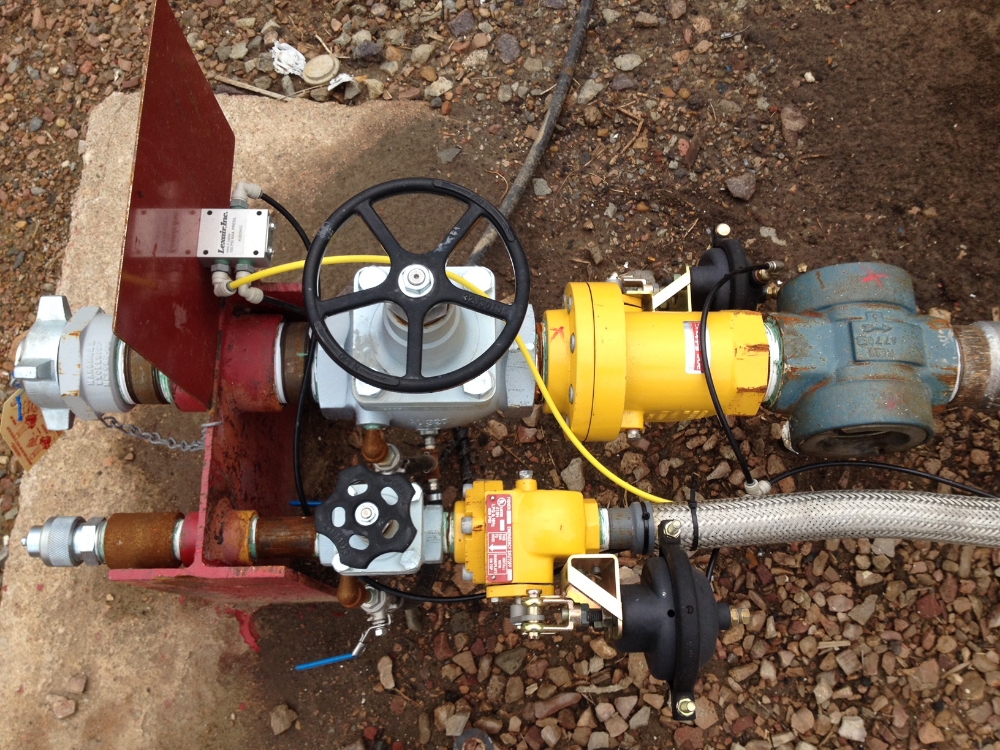
In the Dultmeier Sales world, we most commonly use globe valves in the Anhydrous Ammonia industry. That is the same for angle valves. The most common application we see angle valves used in would be on toolbars or supply risers for Anhydrous Ammonia fertilizer applications. Continental Nh3 Products and Squibb Taylor are our two largest suppliers for these types of valves. An angle globe valve can be viewed below:
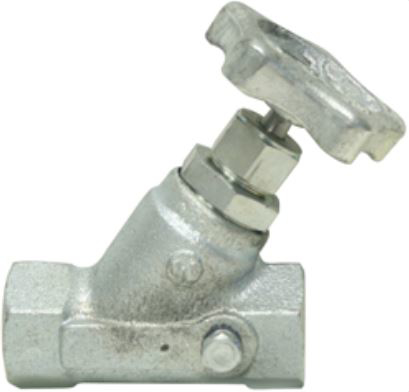
Needle Valves
Next up we will take a look into needle valves and the various applications they can be used for. Most commonly, we see these valves used in higher pressure applications such as car/truck wash and high-pressure cleaning. Here is a grouping of various needle valves on our website, to further illustrate the variety of options. That being said, we do sell a fair amount of needle valves in the Anhydrous Ammonia industry for a bleed off application.
As always, in any application we want to confirm the solution passing through the valve, working or operating pressure range, and temperature of the solution. Below you can view a picture of a needle valve.
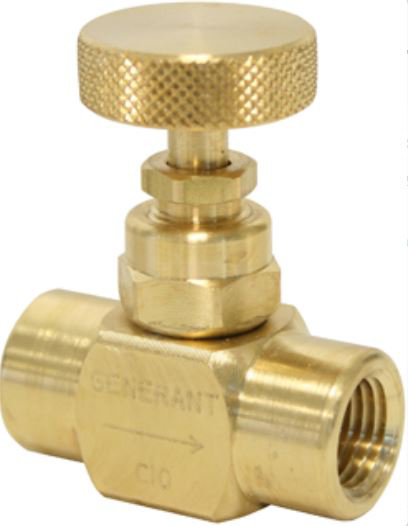
Solenoid Valves
We carry a wide supply of solenoid valves from a number of suppliers. The most notable brands we offer are GC Valves, DEMA, KIP, Kingston and more. A solenoid valve is another example of an electric valve. However, they are drastically different than electric ball valves. That being said, solenoid valves can be controlled remotely and are used in a number of industries.
We most commonly use them in high-pressure vehicle or fleet washing applications, industrial applications, and agriculture or turf spraying applications. Some users in the agriculture industry are starting to migrate away from solenoid valves to ball valves - the primary reason being the necessity for the ruggedness of a ball valve versus over a solenoid valve. Mother Nature in combination with aggressive chemicals is an extremely harsh environment for a valve.
Normally Closed vs. Normally Open
This is an important topic to address - especially in the realm of solenoid valves. If a valve is "normally closed" it means that the valve is closed in its uncharged state. More simply put, if there is no electrical current passing through the valve coil then then it will remain closed. If a valve is "normally open", that means the valve is open in its uncharged state.
Various applications will call for either style. Coils in these valves can be 12 volt, 24 volt, 110 volt and even 240 volt, which allows for a wide and versatile range of applications.
For example, in the vehicle washing industry, we may want to have a weep application on a spray gun. We would do this to ensure the gun doesn't freeze shut in lower temperatures. Therefore, we want ambient water to continuously run through the system or spray gun - if a loss of power occurs. So, in this instance we would want to ensure a normally open valve be installed in this type of a plumbing system.
Solenoid valves are still highly used in the car/truck wash industries due to the fact that they are generally stored in temperature-controlled environments while limiting exposure to the harshness of the natural elements.
Check Valves
Next up, we will look into the world of check valves. This product is used to prevent backflow of a solution in a plumbing system. For instance, a check valve would be utilized when pumping a solution up a vertical pipe and you do not want the solution to backflow, due to gravity, when the pump is turned off. A check valve is a form of backflow prevention.
Furthermore, check valves keep a plumbing system charged. By keeping the system charged we can ensure more efficient delivery of product and reduce the number of air pockets that are present in the plumbing system, which reduces pump priming time and other potential pump problems. The more efficient a plumbing system is - the less it costs to keep it running.
Types of Check Valves
There are multiple types of check valves and each has its own benefits. We will briefly touch on the different types, here. First, is the most efficient type - in terms of maximizing flow characteristics. The swing check valve allows for maximum flow characteristics due to its design that reduces restrictions (i.e. a high coefficient of volume).
Regardless of the check valve style, we need to remember the cracking pressure. The cracking pressure determines the PSI at which the valve opens. Therefore, if a check valve has a cracking pressure of 2 psi it will not open until the plumbing system generates an operating fluid pressure greater than 2 psi. Below is a cross-cut section of a swing check valve:

Secondly, we have a ball check valve. This type of check valve has a preset mechanical spring that allows the valve to open based upon a pre-determined working pressure. These types of check valves are commonly used in high-pressure applications such as car and truck wash, but also within industrial and agricultural applications.
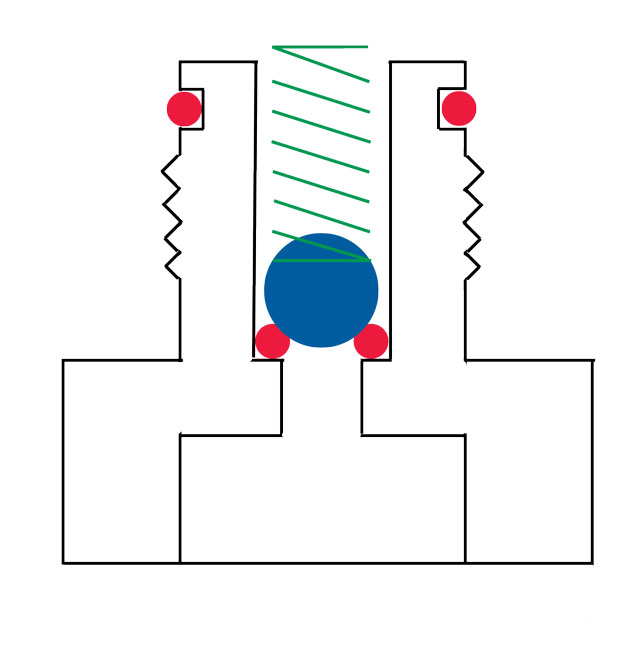
Lastly, there is a plunger style check valve. This style is pictured below:
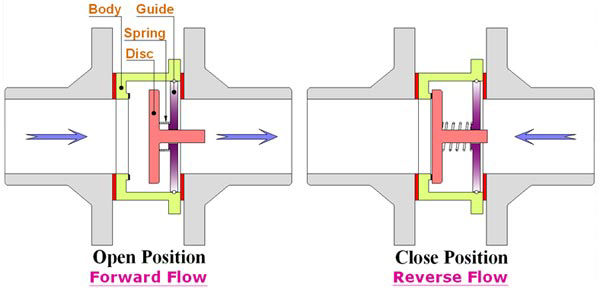
Things to note when ordering a check valve:
- Operating and maximum pressure requirements
- Solution or product passing through the valve - check for chemical compatibility
- Cracking pressure
- Inlet/Outlet size
- Body type (wafer, NPT, flanged, etc)
Regulating Valves
A regulating valve can technically be any valve. In this sense, if you can constrict or control the flow by manipulating the opening threshold of the valve - you have just regulated the system flow.
To that note, we are going to look at this section with this one caveat in mind - a regulating valve needs to be remotely controlled. To do this, let's first look into electric motor driven valves.
There are certain types actuators of ball valves or butterfly valves that manipulate the flow rate of the solution by opening or closing the valve stem a to a certain degree. Without getting too technical this is done in conjunction with some type of flow monitor that is able to communicate with the valve actuator through a control mechanism.
This control mechanism can be a simple rate controller in a sprayer cab or as complex as a computer dashboard in a chemical production facility. The regulating valve communicates to the flow monitor through the system controller to reach and/or maintain the desired flow rate. This controller can be a simple rate controller or a complex computer system.
Regardless of the application - in order to remotely control a regulating valve we must have a controller that sends a signal to the valve based upon the desired flow rate of the operator.
As always, any application we want to confirm the solution passing through the valve, operating pressure range, and temperature of the solution.
Diverter Valves
A diverter valve functions very similarly to a remotely controlled regulating valve. The main difference between a regulating valve and a diverter valve lies within the functionality. A diverter valve is designed only to guide product flow through a system. Therefore, the most common example of this would be a three-way ball valve.
We look at this section with the same caveat in mind - a regulating valve needs to be remotely controlled. To do this, let's first look into electric motor driven valves.
The diverter valve would be remotely controlled through a similar mechanism as a regulating valve. The main difference is that the diverter valve "diverts" flow down fluid path A versus fluid path B - based upon the desired location sent by the controller or computer.
Foot Valves
Foot Valves are commonly used in transfer systems that require the pump to maintain it's prime. A foot valve is essentially a type of check valve. Foot valves are placed at the beginning of a suction line and are generally designed with some type of a strainer or screen to protect the plumbing system from sucking in foreign objects.
If you recall the design of the check valve, you will remember that a check valve closes when there is backflow pressure applied on the spring check. This forces the valve to close and keeps the system suction line primed, with liquid - thus increasing the overall efficiency of the plumbing system. The less time it takes to prime the pump the more efficient the plumbing system becomes. Below you can view a diagram of a plumbing system that includes a foot valve, with strainer.
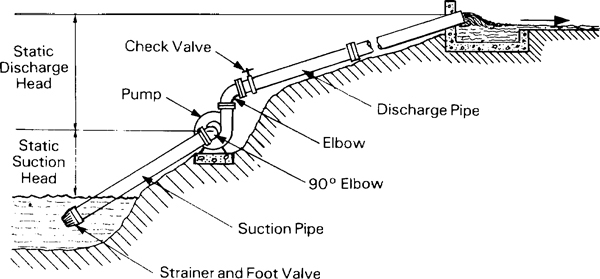
Relief & Unloader Valves
Relief and unloader valves are commonly used in higher pressure situations with positive displacement pumps. These valves are used to protect system components from dead-head scenarios. A positive displacement pump will continue forcing product downstream in a plumbing system until there is a system failure such as a burst pipe, fitting, hose, etc. Thus, the term: dead head scenario. To help combat this scenario, relief and unloader valves were designed. Here is a diagram that explains a relief valve scenario
This video will explain the difference between the two styles of valves. As always, Cat Pumps does an amazing job explaining content.
Back Flow Preventers
In any wash down application where an operation has a water supply line connected to a public water source then it's absolutely necessary, by regulation, to have a back flow prevention valve in place. We distribute for Watts and commonly sell these units in vehicle/fleet wash applications, industrial applications and fertilizer/chemical facility applications. A backflow prevention system products the main water supply in the scenario where a local business would have a system failure and back up chemical, fertilizer, hazardous material, etc. into the main water supply - backflow prevention systems inhibit this scenario from taking place.
Below is an example of a Watts back flow preventer
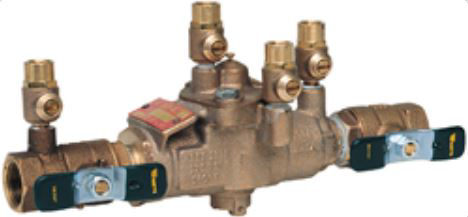
Float Valves
Float valves are used in a wide array of applications. Virtually anywhere you need to maintain the level of a supply tank - you can leverage the assistance of a float valve. Some common float valve product lines that we distribute and carry include BOB Valves, Jobe Valves, Hydro Systems, Kerrick Valve, Dema, Walters Control, and Suttner.
Below is a Dema liquid level proportioning control unit with a siphon breaker.
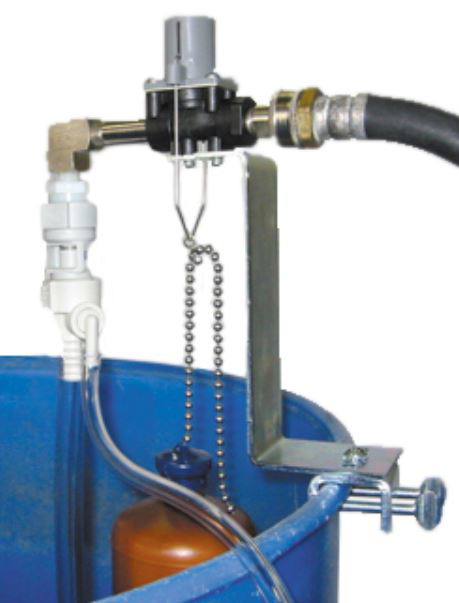
Another application that is extremely common with float valves is in the cattle industry. We sell a unit that allows the user to tie into a warm water source to keep stock tanks from freezing closed in frigid temperatures. The Ice Bull Automatic Ice Prevention System is engineered to automatically open when the stock tank water temperature falls below 42 degrees Fahrenheit.
When the Ice Bull sensor valve opens, .20 gallons per minute of warmer water bypasses the float valve and flows into the tank through the discharge hose. Then, when the water temperature rises above 42 degrees Fahrenheit, the thermo valve shuts off. The Ice Bull Sensor is pictured below:
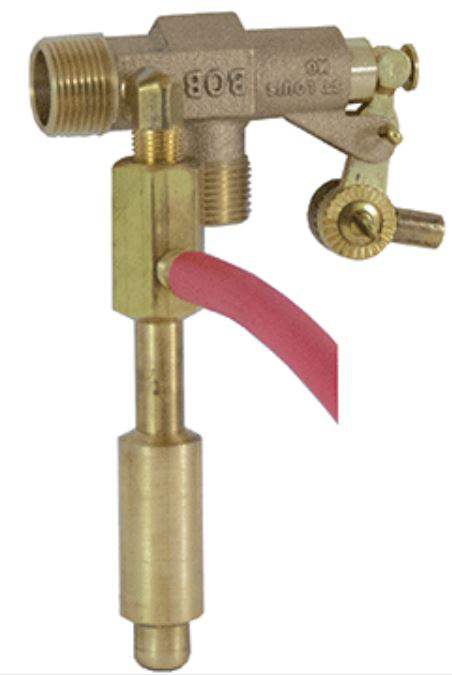
In Conclusion
We hope that this has been a helpful guide to valves. While not all valve types are listed in this post, you have certainly enhanced your general knowledge and should be better prepared to choose the correct valve for your desired application needs.
Don't forget to confirm in any application - the solution passing through the valve, operating pressure range, maximum pressure, and temperature of the solution and always confirm chemical compatibility.
As always, thanks for stopping by and come back soon.













